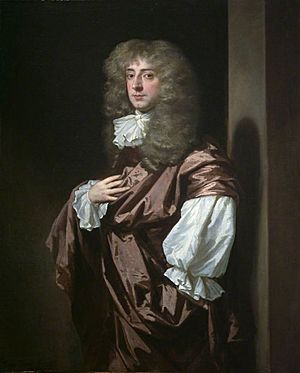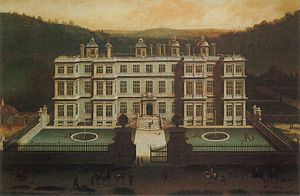Thomas Thynne, 1st Viscount Weymouth facts for kids
Quick facts for kids
The Viscount Weymouth
|
|
|---|---|
 |
|
| President of the Board of Trade | |
| In office 8 January 1702 – 1705 |
|
| Preceded by | The Earl of Stamford |
| Succeeded by | The Earl of Stamford |
| Personal details | |
| Born | 1640 |
| Died | 28 July 1714 (aged 73–74) |
| Spouse | Frances Finch |
Thomas Thynne, who was the 1st Viscount Weymouth, lived from 1640 to 1714. He was an important British nobleman during his time. He held several significant roles in the government and was known for his connection to the famous Longleat House. He also helped found a school that is still open today.
Contents
Early Life and Education
Thomas Thynne was born in 1640. His father was Sir Henry Frederick Thynne. His mother was Mary, the daughter of Thomas Coventry, 1st Baron Coventry. Thomas was educated at Kingston Grammar School. Later, he went to Christ Church, Oxford University in 1657. In 1664, he became a Fellow of the Royal Society, which is a group for important scientists.
Political Career and Roles
Thomas Thynne had a busy career in public service.
Diplomat and Member of Parliament
From 1666 to 1669, he worked as an Envoy to Sweden. This meant he represented England in Sweden. He also served as a Member of Parliament (M.P.). He represented Oxford University from 1674 to 1679. Then, he represented Tamworth from 1679 to 1681.
Becoming a Viscount
In 1679, he inherited the title of 2nd Baronet Thynne. A few years later, in 1682, he was given two new titles. He became the 1st Viscount Weymouth and the 1st Baron Thynne of Warminster. These titles were special because they could be passed down to his brothers if he didn't have male heirs of his own.
Role in the Glorious Revolution
In 1688, Thomas Thynne played a part in a big event called the Glorious Revolution. He helped invite William III, Prince of Orange, to become the new king of England. This happened after King James II left the country.
President of the Board of Trade
From 1702 to 1707, he served as the First Lord of Trade and Foreign Plantations. This job involved managing trade and colonies for England. During this time, he became a Privy Counsellor in 1702. This is a group of advisors to the monarch.
The Lord Weymouth Pine
While working in trade, Thomas Thynne is often linked to the Pinus strobus tree, also known as the Lord Weymouth Pine. He arranged for these trees to be brought to England and planted many of them at Longleat. These pines were useful for making tall, strong ship masts. However, the tree was actually named after an explorer named George Weymouth, who discovered it in America. Thomas Thynne simply helped bring it to England and added "Lord" to its name.
Founding Schools
Thomas Thynne was also interested in education.
Warminster School
In 1707, he started a grammar school for boys in Warminster. This school offered 23 free places for local boys. It later became known as the Lord Weymouth School. In 1973, this school joined with a girls' school to form Warminster School, which is still open today. The school remembers him by naming a building after him.
Carrickmacross School
Thomas Thynne also planned to build a school in Carrickmacross, Northern Ireland. He wanted it to be a good school that would help the town. However, his agent there misused the money meant for the school. It took ten years for Thomas to find out. The school was eventually built and taught subjects like "Oratory, Virtue, Surveying [and] Antiquities." Unlike Warminster School, this school closed in 1955.
Longleat House and the Thynne Family
Longleat House is a famous country estate. It was bought by Sir John Thynn in 1541. He was the first of the Thynne family to own it. The family name has changed slightly over the years, from Thynn to Thynne and back again.
Building and Gardens
The original house at Longleat burned down in 1567. A new house was built by 1580. Many people helped with the design, but Sir John Thynn did most of the work. Thomas Thynne, the 1st Viscount Weymouth, started the house's huge book collection. He also loved gardens. He hired George London to design beautiful formal gardens with fountains and flower beds. These gardens stretched out from the house, making the surroundings very decorative.
Longleat Today
Longleat House is still the home of the Thynne family. The title of Viscount Weymouth has been held by the Marquesses of Bath since 1789. More recently, Alexander Thynn, the 7th Marquess of Bath, was an artist. He created several mazes and labyrinths on the property, like the hedge maze and the love labyrinth.
Bishop Ken, a Special Guest
Thomas Ken, who was the Bishop of Bath and Wells, became a close friend of Thomas Thynne. In 1691, Bishop Ken lost his position because he refused to change his loyalty from King James II. Thomas Thynne offered him a place to live at Longleat and gave him money each year.
Bishop Ken lived on the top floor of Longleat for about twenty years. He had a big influence on Thomas Thynne. Many people believed that Bishop Ken inspired Thomas to do good deeds. For example, they worked together to found the Lord Weymouth School. A part of the house was even turned into a chapel for daily worship. Bishop Ken wrote many famous hymns while living there, and when he died in 1711, he left his large library to Thomas Thynne.
Irish Lands
Thomas Thynne also gained land in Northern Ireland in 1692. This land came from an agreement between the heirs of a nobleman named Robert Devereux. Thomas Thynne received a larger share of the land than another family, the Ferrers. However, he acted fairly to correct this imbalance.
There was a story that in 1694, a Polish baron wanted to rent a large area of land and the town of Carrickmacross in Ireland from Thomas Thynne. The baron wanted to settle 200 Protestant families from Silesia there. Thomas agreed, but the plan was canceled when the baron said he wanted to tear down the town and rebuild it in a Polish style.
Family Life
Thomas Thynne married Frances Finch before 1672. They had four sons, including Henry Thynne (1675–1708), and a daughter named Frances. Sadly, all of his children passed away before him. This meant he had no direct male heirs to inherit his titles and estates. He passed away in 1714. His estates went to his grand-nephew, also named Thomas Thynne. This grand-nephew is an ancestor of the Marquesses of Bath.
Images for kids



